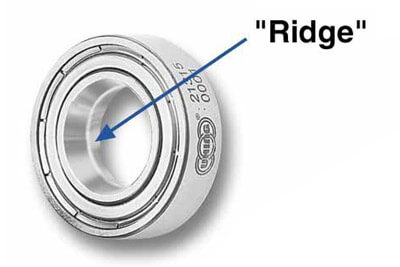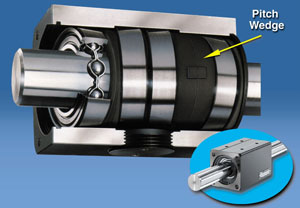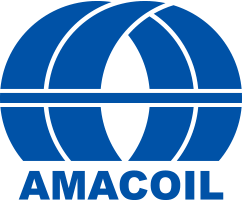How It Works – RS Linear Drive
Rolling Ring Linear Motion Converts Rotary Motion Input into Linear Output
In a rolling ring RS drive, the rotary input motion provided by a motor-driven threadless shaft (included only in ARS assembly) is converted into linear output. Here’s how its done:
Specially Machined Bearings Contact Shaft
 The inner race of a rolling ring bearing is machined to form a sort of “ridge” which runs around the entire inner race of the bearing. When mounted on a shaft, the bearing contacts the shaft at a single point on this ridge.
The inner race of a rolling ring bearing is machined to form a sort of “ridge” which runs around the entire inner race of the bearing. When mounted on a shaft, the bearing contacts the shaft at a single point on this ridge.
In a rolling ring linear drive, three or four rolling ring bearings are housed inside the nut. When the nut is placed on a smooth shaft, and the shaft is rotated, compression is generated against the bearings’ inner races. This causes the bearings to roll along the length of the shaft. A payload attached to the nut is thereby moved linearly.
Pitch Control Wedges Determine Linear Pitch
 Pitch in an RS rolling ring linear drive is fixed. The RS is available in five (5) different pitch settings that are determined by pitch wedges that are factory set prior to shipment. The RS comes standard with a pitch setting of 0.5 times the shaft diameter. Each RS drive is also available with four other optional pitch settings: 0.1, 0.2, 0.3 and 0.4 times the shaft diameter.
Pitch in an RS rolling ring linear drive is fixed. The RS is available in five (5) different pitch settings that are determined by pitch wedges that are factory set prior to shipment. The RS comes standard with a pitch setting of 0.5 times the shaft diameter. Each RS drive is also available with four other optional pitch settings: 0.1, 0.2, 0.3 and 0.4 times the shaft diameter.
